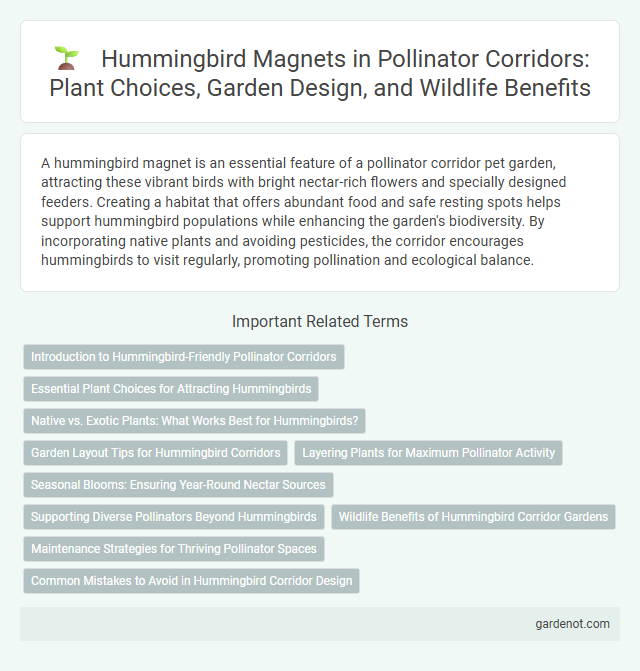A hummingbird magnet is an essential feature of a pollinator corridor pet garden, attracting these vibrant birds with bright nectar-rich flowers and specially designed feeders. Creating a habitat that offers abundant food and safe resting spots helps support hummingbird populations while enhancing the garden's biodiversity. By incorporating native plants and avoiding pesticides, the corridor encourages hummingbirds to visit regularly, promoting pollination and ecological balance.
Introduction to Hummingbird-Friendly Pollinator Corridors
Hummingbird-friendly pollinator corridors create vital pathways that support the migration and feeding needs of hummingbirds by connecting diverse habitats rich in nectar-producing flowers. These corridors enhance local biodiversity and boost ecosystem resilience by offering continuous access to food sources throughout hummingbird breeding and migration seasons. Planting native flowering species such as bee balm, columbine, and salvia within these corridors maximizes hummingbird attraction and sustains pollination networks.
Essential Plant Choices for Attracting Hummingbirds
Choosing nectar-rich plants such as trumpet vine, bee balm, and salvia is essential for creating a hummingbird magnet pollinator corridor. These species provide vibrant colors and tubular flowers that specifically attract hummingbirds while offering abundant energy sources. Incorporating native plants like columbine and cardinal flower enhances habitat suitability and supports local hummingbird populations effectively.
Native vs. Exotic Plants: What Works Best for Hummingbirds?
Native plants provide tailored nectar sources and suitable habitats for hummingbirds, enhancing their foraging efficiency and breeding success. Exotic plants may offer nectar but often lack the ecological compatibility needed to support hummingbird populations fully. Prioritizing native flora in pollinator corridors maximizes hummingbird attraction and sustains local biodiversity.
Garden Layout Tips for Hummingbird Corridors
Plant clusters of native nectar-rich flowers like Salvia, Trumpet Vine, and Bee Balm to create continuous feeding stations that attract hummingbirds. Incorporate vertical layers by using shrubs, small trees, and flowering vines to enhance visibility and provide shelter while guiding hummingbird movement. Position water features and perching spots strategically within the garden layout to support hydration and resting, optimizing the corridor's effectiveness.
Layering Plants for Maximum Pollinator Activity
Layering plants with vibrant blooms at varying heights creates an ideal habitat for hummingbirds and other pollinators, boosting their activity throughout the day. Incorporate a mix of tubular flowers such as trumpet vine, columbine, and bee balm alongside low-growing nectar sources like salvia and phlox to attract hummingbirds effectively. This strategic plant layering enhances visibility and accessibility of nectar, supporting a thriving pollinator corridor ecosystem.
Seasonal Blooms: Ensuring Year-Round Nectar Sources
Hummingbird magnets with diverse seasonal blooms provide continuous nectar sources vital for sustaining hummingbird populations throughout the year. Including native plants like trumpet vine in summer and coral honeysuckle in spring creates a dynamic pollinator corridor supporting migratory patterns. This strategic planting enhances ecological stability by promoting long-term habitat availability for hummingbirds.
Supporting Diverse Pollinators Beyond Hummingbirds
Hummingbird magnets designed with native flowering plants not only attract hummingbirds but also support a wide range of pollinators such as bees, butterflies, and moths. Incorporating varied flower shapes, colors, and bloom times creates continuous resources that sustain diverse pollinator species throughout the season. Enhancing habitat complexity within pollinator corridors boosts ecosystem resilience and promotes biodiversity beyond just hummingbirds.
Wildlife Benefits of Hummingbird Corridor Gardens
Hummingbird corridor gardens enhance biodiversity by providing essential nectar sources that support hummingbird populations and other pollinators. These gardens create continuous habitats that facilitate safe migration routes, increasing pollination efficiency for native plants. Establishing pollinator corridors helps maintain ecosystem balance and promotes the survival of diverse wildlife species reliant on these habitats.
Maintenance Strategies for Thriving Pollinator Spaces
Regular pruning of hummingbird magnet plants enhances flower production, attracting more pollinators to the corridor. Consistent watering schedules ensure vibrant blooms, supporting sustained nectar availability for hummingbirds. Incorporating organic mulches reduces weed competition and maintains soil moisture, promoting healthier pollinator habitats.
Common Mistakes to Avoid in Hummingbird Corridor Design
Placing feeders too close to windows often causes fatal bird collisions, which should be avoided in hummingbird corridor design. Selecting non-native plants that do not provide adequate nectar disrupts the natural habitat and reduces hummingbird visitation rates. Neglecting layered vegetation structure limits shelter and nesting opportunities, diminishing the corridor's effectiveness as a pollinator habitat.
Hummingbird magnet Infographic

 gardenot.com
gardenot.com